

Cowcotland. ASRock Z97 Extreme6 Review: Ultra M.2 x4 Tested With XP941. As part of our review, ASRock sent us the 512 GB Samsung XP941 M.2 drive to test how ASRock has implemented the feature.
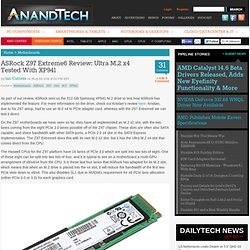
For more information on the drive, check out Kristian’s review here. Kristian, due to his Z87 setup, had to use an M.2 x4 to PCIe adapter card, whereas with the Z97 Extreme6 we can test it direct. On the Z97 motherboards we have seen so far, they have all implemented an M.2 x2 slot, with the two lanes coming from the eight PCIe 2.0 lanes possible off of the Z97 chipset. These slots are often also SATA capable, and share bandwidth with other SATA ports, a PCIe 2.0 x4 slot or the SATA Express implementation. The Z97 Extreme6 does this with its own M.2 x2 slot, but it has the Ultra M.2 x4 slot that comes direct from the CPU. The Haswell CPUs for the Z97 platform have 16 lanes of PCIe 3.0 which are split into two lots of eight. However the upshift from x2 to x4 shows the effect of a drive restricted against a drive that can stretch its legs. Now on to two-way CrossFire: Samsung SSD XP941 Review: The PCIe Era Is Here. When SATA was introduced a bit over a decade ago, it provided major advantages over the old PATA interface.
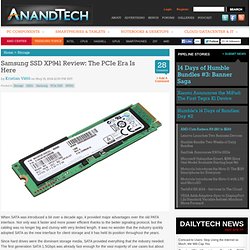
Not only was it faster and more power efficient thanks to the better signaling protocol, but the cabling was no longer big and clumsy with very limited length. It was no wonder that the industry quickly adopted SATA as the new interface for client storage and it has held its position throughout the years. Since hard drives were the dominant storage media, SATA provided everything that the industry needed. The first generation SATA 1.5Gbps was already fast enough for the vast majority of use cases but about two years after the initial release of SATA, the second generation SATA was ready for prime time, doubling the throughput to 3Gbps. Even today's fastest hard drives can't fully saturate SATA 3Gbps, so there was obviously no rush to improve the interface as it already met the industry's needs. SATA Express et Z97 / H97 : flou volontaire ? Instalation d'une carte REVODRIVE X2 de OCZ - Le blog de Association Lorraine Aide Informatique Nancéienne.
Lundi 2 mai 1 02 /05 /Mai 08:36 Ce message a pour but de partager les divers problèmes que j'ai rencontrés par cette combinaison carte mère Asus Saberthooth X58 + Revodrive X2 de OCZ ainsi qu'avec un disque dur Vélociraptor (10 000 tr/min) qui ont pu me poser beaucoup de soucis, de son installation à son exploitation, qui aujourd'hui n'en pose plus.

Je pense que certains paramètres effectués seraient aussi valables pour d'autres versions de cette carte, voire d'autres cartes mères. Assemblage: M.2 (NGFF) SSD Compatibility List. This post is an attempt to dispel any confusion around the new M.2 SSD format, and has been developed as a resource for RamCity staff, customers and anyone else with an interest.

A special mention needs to go Kent Smith of LSI. This blog post he wrote helped clarify some of the finer points contained here. Intel Sockel 1150 mit div. Schnittstellen: M.2 32Gb/s Preisvergleich. Samsung XP941 256GB M.2 NGFF PCIe Solid state drive SSD (2280) ( MZHPU256HCGL-00000 ) - Flexx ram. Up to 1170Mb/s read speed | 256GB Up to 512GB capacity | M.2 | PCIe 4-lane | less than 4mm thick | 8 grams If you intend to purchase this product as an upgrade for an existing smaller drive, you should check if the existing drive is a Samsung XP941 or other M.2 PCIe SSD.

Review our M.2 SSD compatibility list blog post if you are not sure if this drive is compatible in your machine. Slim Package, Big Performance The new Samsung XP941 M.2 PCIe SSD delivers a level of performance that easily surpasses the speed limit of a SATA 6Gb/s interface. With sequential data reads as high as an incredible 1,170MB/s (megabytes per second) on the 512GB model, the XP941 provides the highest possible performance available with a PCIe 2.0 interface.
The new standard.
Asrock. ASUS. ASUS is ready for SATA Express - Early tech and performance preview. In May 2011, SandForce released the first SSD bottlenecked by the SATA III bus.

It was just five months after Intel released the P67 Express chipset, Intel's first native SATA III capable release. Until then, PATA and SATA lived long, fulfilling lives, always ahead of the performance curve offered by new data storage products. This fact is just one reason why we call flash-based storage a disruptive technology. Photo for demonstration purposes only The standards body, SATA-I/O, quickly jumped into action. Samsung XP941 : un SSD pour Ultrabook à 1,4 Go/s. Des SSD M.2 à 1,4 Go/s pour PC chez BPlus. SSD M.2Dans le monde des SSD, une nouvelle technologie émerge peu à peu : les SSD en PCI-Express.
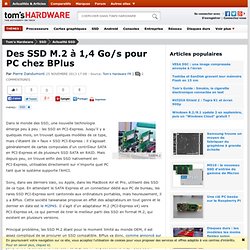
Jusqu'il y a quelques mois, on trouvait quelques modèles de ce type, mais c'étaient de « faux » SSD PCI-Express : il s'agissait généralement de cartes composées d'un contrôleur SATA en PCI-Express et de plusieurs SSD SATA en RAID. Mais depuis peu, on trouve enfin des SSD nativement en PCI-Express, utilisables directement sur n'importe quel PC tant que le système supporte l'AHCI. Sony, dans ses derniers Vaio, ou Apple, dans les MacBook Air et Pro, utilisent des SSD de ce type.
En attendant le SATA Express et un connecteur dédié aux PC de bureau, les rares SSD PCI-Express sont cantonnés aux ordinateurs portables, mais heureusement, il y a BPlus. NGFF - Flux de contenus pour le tag. Highest Performing Samsung XP941 Native PCIe M.2 SSD Available For Pre-Order. Normally we might elect to post availability of a product, but for the number of e-mails received after our review of the Samsung XP941 PCIe X4 M.2 SSD in September of 2013.
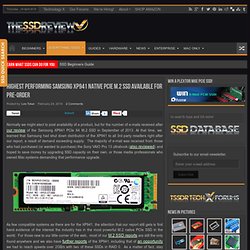
At that time, we learned that Samsung had shut down distribution of the XP941 to all 3rd party resellers right after our report, a result of demand exceeding supply. The majority of e-mail was received from those who had purchased (or wanted to purchase) the Sony VAIO Pro 13 ultrabook (also reviewed) and hoped to save money by upgrading SSD capacity on their own, or those media professionals who owned Mac systems demanding that performance upgrade. As few compatible systems as there are for the XP941, the attention that our report still gets is first hand evidence of the interest the industry has in the most powerful M.2 native PCIe SSD in the world. Much of the background work and final product, of small websites such as ourselves, comes without return and solely through love of what we are doing.
À défaut de SATA Express, les Z97 et H97 supporteront les SSD PCIe au format M.2. Vous avez pleuré quand vous avez su qu’Intel n’intègrerait pas le SATA Express sur les chipsets de la série 9.

Puis, vous avez sauté de joie en apprenant qu’Asus avait intégré, sur un prototype de carte mère Z87, un connecteur SATA Express, directement relié aux lignes PCI Express du chipset. SSD Guide: PCI-Express, M.2, mSATA And SATA Express – The Differences Explained! Connector vs Protocol SSDs are practically ubiquotous in modern PCs and gaming notebooks.
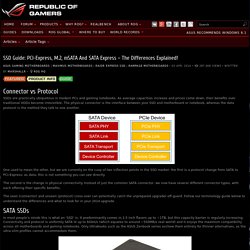
As average capacities increase and prices come down, their benefits over traditional HDDs become irresistible. The physical connector is the interface between your SSD and motherboard or notebook, whereas the data protocol is the method they talk to one another. One used to mean the other, but we are currently on the cusp of two inflection points in the SSD market: the first is a protocol change from SATA to PCI-Express; as data, this is not something you can see directly.
The second is the change in physical connectivity. The seen (connector) and unseen (protocol) cross-over can potentially catch the unprepared upgrader off-guard. Samsung mise sur le Sata Express pour ses SSD. Lors de son événement SSD Global Summit, Samsung nous a confié travailler sur la nouvelle interface appelée Sata Express pour ses futurs SSD.
D'après le constructeur, il serait possible de doubler les taux de transferts ! Les limites du Sata 3 (6 Gbps) ayant été très rapidement atteintes avec un plafond à 500 Mo/s, les constructeurs doivent trouver une nouvelle interface pour augmenter les débits. La relève est heureusement prévue avec le SATA Express. Comme son nom l'indique, ce connecteur - également connu sous l'appellation Sata 3.2 - s’appuie sur la technologie PCI Express. SSD PCI-E et SATA Express - Flux de contenus pour les tags. Micron lance un SSD original puisque combinant une interface PCI-Express et un format 2.5", le RealSSD P320h 2.5. Jusqu'alors les SSD PCI-Express prenaient la forme d'une carte file, comme c'est le cas pour le RealSSD P320h classique.
Cette nouvelle version permet le hotswap mais nécessite un système compatible comme c'est le cas des serveurs Dell PowerEdge de 12è génération. Micron ne donne pas vraiment plus de détail si ce n'est qu'il est en cours d'échantillonnage, alors que la photo montre une version 175 Go en SLC. Les cartes mères Asus Z97 se dévoilent dans leur plus simple appareil. Après le leak des cartes mères Z97 et H97 de MSI, c'est au tour de celles d'Asus de se dévoiler en images. 5 modèles ont été leakés sur le réseau social Chinois Weibo : trois de la gamme ROG, une Sabertooth et une Deluxe.
Pour les ROG, ce sont les Maximus VII Hero, Maximus VII Gene et Maximus VII Range qui ont été dévoilées en image et qui reprennent le design noir et rouge qui les distinguent des autres gammes. Z97 Express - Flux de contenus pour le tag. WCCFTech a publié les caractéristiques de la gamme Z97 Gaming de MSI. On retrouve les bases de la gamme Z87, à savoir du noir avec une touche de rouge, une puce réseau Killer E2200 et une partie audio améliorée par rapport à la gamme classique. Il est désormais question de Audio Boost 2, sans que l'on sache quelle est la différence par rapport à l'Audio Boost des Z87 basé sur un codec Realtek ALC1150. Les chipsets Série 9, Intel, elle sont où les promesses ?
Intel : le chipset série 9 de Broadwell serait-il incompatible avec Haswell ? Sans réelle surprise, une nouvelle génération de chipsets accompagnera le lancement des prochains processeurs Intel du nom de code Broadwell. Alors que l'on ne les attend que pour le milieu de l'année prochaine, un premier document en fuite et relayé par VR-Zone fait état de quelques changements internes notamment sur certaines entrées de tension. Si ces modifications nécessitent à coup sûr un nouveau design de cartes mères, on rappellera toutefois que le socket restera quant à lui sur du LGA 1150. On peut alors légitimement se demander si les processeurs Haswell pourront s'installer sans problèmes sur cette nouvelle ligne de cartes mères et son nouveau chipset. Dans l'état, il semble que la réponse soit négative.
Chipsets Series 9, Intel vise l'évolution et non la révolution. Intel se prépare à libérer ses processeurs Haswell Refresh ainsi qu’une nouvelle série de chipsets, la Series 9. Les nouveautés seront minimes selon un nouveau document publié. Proposé par Hermitage Akihabara, cette présentation des Intel 8 Series Chipsets, qui accompagneront les Haswell Refresh, ne s’annonce pas comme une révolution, loin de là. Intel Chipset Serie 9 : avec du Sata Express ? David vous a présenté début janvier la technologie Sata Express, successeur tout désigné par le SATA-IO du Sata 6Gbps.